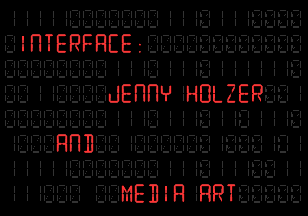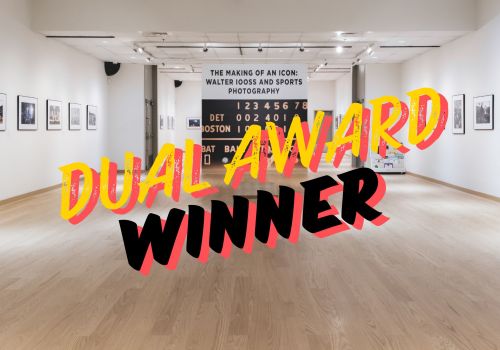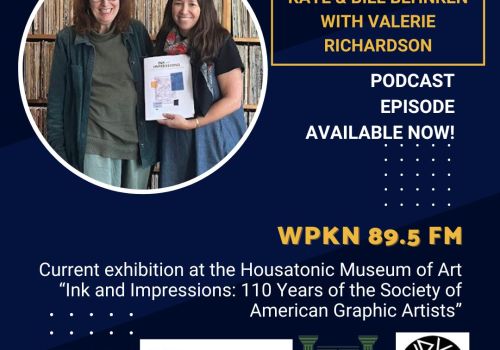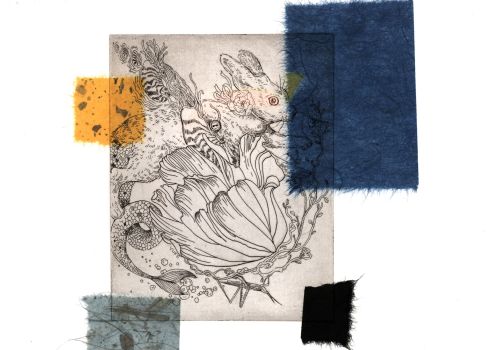
INTERFACE: JENNY HOLZER AND MEDIA ART 2004
INTERFACE: JENNY HOLZER AND MEDIA ART 2004
 |
 © 2004 Jenny Holzer / Artists Rights Society (ARS) New York © 1997 antenna tool & die co. All rights reserved |
|
January 22 - March 26, 2004 Opening Reception: Thursday, January 29, 2004, 12:30 - 2:30 pm Curated by Robbin Zella |
|
TECHNOLOGY WILL MAKE OR BREAK US
The Housatonic Museum of Art will present Interface: Jenny Holzer and Media Art curated by Robbin Zella from January 22 through to March 26, 2004. There will be an opening reception Thursday, January 29th from 12:30 until 2:30pm in the gallery. This event is free and the public is cordially invited to attend.
Since Jenny Holzer’s Truisms first appeared on the streets of New York in 1977, she has been steadily developing a method of appropriation and quotation to offer a feminist critique of a consumer society. Her Truisms – a series of one-line texts presented to the viewer in unexpected places- have been printed on glasses, T-shirts, golf-balls, coffee mugs, and pencils; they have been carved into benches and picnic tables, and encoded into LEDs, inserted as commercials on cable and network television in California and Connecticut (Art Breaks), and published on the Internet (ada-web). All of the vehicles that Holzer has selected for her words are also used in advertising. By appropriating an established public or commercial site and by using a form of quotation, such as mimicking advertising slogans, she is able to subvert both the vehicle and the message to offer an investigation into the values of our society. For example, in 1982 Holzer was invited to create a project through the Public Art Fund in New York City. She programmed the Times Square Spectacolor Board with selections from her Truisms, on of which was PROTECT ME FROM WHAT I WANT. As this ironic plea hovered silently above the crowd, it created a rupture in the physical environment of advertising messages and purchasing directives and a gap through which awareness of an economic issue or a personal lifestyle choice could emerge.
Holzer’s Lustmord series developed as her response to the fighting in Bosnia and, more specific, to crimes against women committed during the war. Images can advance a point of view, manipulated by what we see and, as importantly, what we don’t see. Holzer’s juxtaposition of media-text and photography-creates a poignant image of warfare. She photographs text written on women’s skin, powerfully stating that these bodies have become sites of conflict. Through a strong narrative text, she projects an image of society in which such conflict, on or off the battlefield, exists; privilege, consent, authorization, permission, justification, power and powerlessness are the subtexts of these works.
Similarly, her Laments series (vertical LED diptych) reveals the rules and structures underlying personal behavior and social systems.
Ultimately, Jenny Holzer emerges as an artist/activist working in opposition to established authority as represented by the popular media. She penetrates our communication systems, our vehicles of communication- paper, stone, electronic signage, television, and computers, in order to dissect our beliefs and expose the contradictions within our social reality.
Jenny Holzer was born in Gallipolis, Ohio on July 29, 1950. She studied at Duke University for two years before transferring to the University of Chicago. Holzer received her B.F.A. from Ohio University in 1972. She continued studying painting and printmaking at the Rhode Island School of design, where she met her husband, fellow artist Mike Glier. She was awarded her MFA from RISD in 1977 and was then accepted into the prestigious Whitney Museum Independent study program where she developed her first “Truisms.” In 1990, Holzer was selected to represent the United States in the American Pavillion, 44th Venice Biennale. Jenny Holzer lives in Hoosick Falls, New York with her husband and daughter, Lily.


